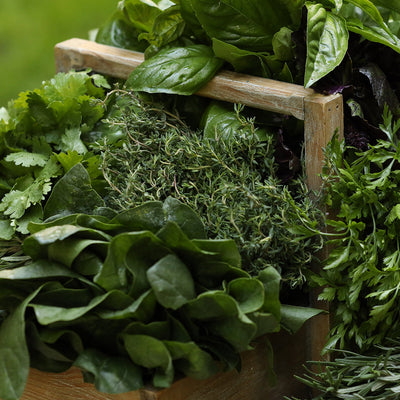White vs Brown Rice: Why Is Brown Rice Healthier?

The next time you reach for the white rice, you may want to reconsider. Brown rice is the hands-down healthier choice for your dinner grain.
Brown rice is essentially what white rice looks like before it’s refined. Processing removes the outside hull or husk from both white and brown rice. To turn de-hulled brown rice into the white rice we buy in stores, processing further removes the bran and germ.[1] As a result of these steps, processed white rice is lighter in color and cooks faster than brown rice.
Although processing was initially implemented to make rice more shelf-stable, it has the side effect of removing nutrients, including fiber, thiamine (vitamin B1), calcium, phosphorus, iron, manganese, magnesium, and potassium.[2]
Have you noticed white rice is usually labeled as "enriched" or "fortified"? Just like white flour is enriched, white rice usually contains unnatural additives. These nutrients are added because the stripping process removes most of the vitamins and minerals from the rice.[1, 2]
After first removing the bran and germ, which hold nutrients, manufacturers enrich and fortify white rice with vitamins and minerals to get back some of the lost nutrients.[3] This is one of the main reasons why a side by side comparison of enriched white rice and brown rice suggests they have comparable levels of minerals and vitamins.[4, 5] Sometimes the enriched white rice may even list higher levels of certain nutrients; however, this is because synthetic vitamins and minerals were added to a food product that had been stripped of its previous nutritional value.
Added nutrients are not of the same quality as those that come from whole, natural foods. Studies have found that nutrients found in whole foods are used more effectively by the body than those given supplementally.[6] I always say that you should get most of your nutrition from nutritious, organic food, and supplement where your diet is lacking.
Differences Between White Rice and Brown Rice
1. Brown Rice Is Rich in Selenium
Brown rice is extremely high in selenium. One cup of cooked brown rice provides 27% of the US Food & Drug Administration (FDA) recommended daily value (%DV).[7] Selenium is a trace mineral that supports the body in many ways. Selenium, along with iodine, is an important nutrient that’s necessary for the thyroid to produce hormones.
2. Brown Rice Is High in Manganese
One cup of brown rice provides a whopping 88% of our daily manganese requirements.[4] Manganese helps the human body create the important fatty acids that make healthy forms of cholesterol. It is also beneficial to the health of our nervous and reproductive systems.
3. Brown Rice May Reduce Bad Cholesterol
Brown rice contains small amounts of heart-healthy rice ban oil, although most of the oil is removed during processing. Studies have found that brown rice can help lower low-density lipoprotein (LDL), aka bad cholesterol. One study found that while fiber offers its own benefits, it was the rice bran oil rather than fiber that lowered cholesterol by 7% in volunteers.[8]
4. Brown Rice Promotes Weight Loss
Because of its fiber-richness and ability to support healthy bowel function, brown rice keeps things moving in a way that may promote weight-loss and metabolic function. People who replaced refined grains with whole grains had an increased resting metabolic rate – meaning they burned more calories – and eliminated more energy in their stool, but this was above and beyond the effect of the fiber.[9] It turns out that the whole grains improved the digestibility of other foods eaten, resulting in a higher metabolism.[10] Because of the fiber-rich nature of this grain, just one bowl of brown rice can satisfy your appetite and help you feel full.
5. Brown Rice Is a Whole Grain
Unlike white rice, brown rice is a whole grain according to the FDA. People who eat more whole grains have healthier overall diets compared with people who do not. A nationally representative sample of people from the U.S. found that individuals who eat more whole grains had better diet quality and consumed more fiber and polyunsaturated fatty acids, and less sugar, saturated fatty acids, and cholesterol.[11] Studies show that whole grains can lower the creation of arterial plaque build-up and reduce chances of developing heart disease and high cholesterol.[12]
6. Brown Rice Has Antioxidant Properties
Most people associate antioxidants with blueberries, but many are unaware that brown rice is also a source of antioxidants.[13] Red and black wild rice have even more phenolic compounds – a type of antioxidant– than brown rice. However, the phenolic compounds in brown rice increase substantially if the brown rice is germinated before eating.[14]
7. Brown Rice Is High in Fiber
Studies have correlated the high use of whole grains like brown rice with lowered levels of diseases that affect the colon.[15] Although scientists are not sure of the exact mechanism by which this effect happens, one science hypothesis is related to its high fiber content. Some studies show that fiber attaches to cancer-causing substances and toxins, helping to eliminate them from the body, and keeping them from attaching to the cells in our colon.[16] Brown rice also contains the necessary components to stabilize digestion, prevent/relieve constipation and promote proper elimination/bowel function.
8. Brown Rice Is a Slow-Release Carb
Unlike white rice, brown rice can help keep blood sugar stabilized as it releases sugars slowly and in a sustained fashion. Studies have shown a link between the consumption of white rice and a higher risk of type 2 diabetes. Further research shows that individuals who replace white with brown rice weekly can reduce their chances of developing this condition by up to 16 percent.[17]I personally recommend using organic wild brown rice as the best option. But, even if you don't buy organic, just making the switch from white rice to brown rice is a great first step to a healthy diet.
Brown Rice and Arsenic: A Caution
There has been a lot of news about arsenic in rice, particularly in brown rice. Arsenic is a naturally occurring element found in soil, and exposure to or consumption of high amounts have serious negative health effects.[18] When growing in soil, rice naturally takes up the arsenic, and because this is a natural process, even organically-grown varieties of rice can contain arsenic.[18] The arsenic accumulates in the outer layers of a rice kernel, which are removed during processing of white rice, which is why levels are higher in brown rice.
The Food Safety and Sustainability Center tested 128 varieties of rice and found that brown basmati rice from California, Pakistan, and India had the lowest levels of arsenic – about one-third less than other brown rice varieties. Rice of all varieties from Arkansas, Texas, and Louisiana – and from the U.S. anywhere – had the highest amounts of arsenic.[19] Other gluten-free grains you can look for with low or nonexistent levels of inorganic arsenic include buckwheat, amaranth, millet, and polenta.[19]
According to the FDA, you can remove 40-60% of the arsenic from rice by cooking it in excess water (6-10 parts water to one part rice) and then draining off the extra water after cooking. With white rice, this also reduces the nutrition, because companies fortify the product by adding vitamins and minerals as a powder on the outside the rice kernel. However, the naturally occurring nutrients of unprocessed brown rice reside inside the kernel, so draining off excess cooking water will not reduce its nutritional content.[18]
I recommend using organic wild brown rice as the best option. But, even if you don't buy organic, just making the switch from white rice to brown rice is a great first step to a healthy diet.
References (19)
- Puri S, et al. "Effect of Degree of Milling (Dom) on Overall Quality of Rice - A Review." Int J Adv Biotechnol Res. 2014;5(3),474-489.
- Trinkley M, Fick S. "Rice Cultivation, Processing, And Marketing In The Eighteenth Century." Accessed 8 May 2017.
- Ashong J, et al. "Fortification of rice with vitamins and minerals for addressing micronutrient malnutrition." Cochrane Database of Systematic Reviews. 2012;6.
- "Rice, Brown, Long-Grain, Cooked Nutrition Facts & Calories." Nutritiondata.self.com. Accessed 8 May 2017.
- "Rice, White, Long-Grain, Regular, Cooked Nutrition Facts & Calories." Nutritiondata.self.com. Accessed 8 May 2017.
- Clarke JD, et al. "Bioavailability and inter-conversion of sulforaphane and erucin in human subjects consuming broccoli sprouts or broccoli supplement in a cross-over study design." Pharmacol Res. 2011; 64(5),456–463.
- "Office Of Dietary Supplements - Dietary Supplement Fact Sheet: Selenium." Ods.od.nih.gov. 2 Mar. 2018. Accessed 11 Apr. 2018.
- Most MM, et al. "Rice bran oil, not fiber, lowers cholesterol in humans." Am J Clin Nutr. 2005;81(1),64-8.
- Karl JP, et al. "Substituting whole grains for refined grains in a 6-wk randomized trial favorably affects energy-balance metrics in healthy men and postmenopausal women." Am J Clin Nutr. 2017;105(3),589-599.
- "New Study Suggests That Eating Whole Grains Increases Metabolism And Calorie Loss." Tufts Now. 8 Feb. 2017. Accessed 11 Apr. 2018.
- O'Neil CE, et al. "Whole-grain consumption is associated with diet quality and nutrient intake in adults: the National Health and Nutrition Examination Survey, 1999-2004." J Am Diet Assoc. 2010;110(10),1461-8.
- Mellen PB, et al. "Whole grain intake and cardiovascular disease: a meta-analysis." Nutr Metab Cardiovasc Dis. 2008 ;18(4),283-90.
- Min, B., A.M. McClung, and M.H. Chen. "Phytochemicals And Antioxidant Capacities In Rice Brans Of Different Color." J Food Sci. 2017;76(1),117-126.
- Tian S, et al. "Analysis of phenolic compounds in white rice, brown rice, and germinated brown rice." J Agric Food Chem. 2004;52(15),4808-13.
- Aune D, et al. "Dietary fibre, whole grains, and risk of colorectal cancer: systematic review and dose-response meta-analysis of prospective studies." Br Med J. 2011; 343,d6617.
- Jacobs LR. "Relationship between dietary fiber and cancer: metabolic, physiologic, and cellular mechanisms." Proc Soc Exp Biol Med. 1986;183(3),299-310.
- Sun Q, et al. "White rice, brown rice, and risk of type 2 diabetes in US men and women." Arch Intern Med. 2010;170(11),961-9.
- "Questions & Answers: Arsenic in Rice and Rice Products." U.S. Food & Drugs Administration. 25 Oct 2017. Accessed 11 Apr. 2018.
- "How Much Arsenic Is in Your Rice?" Consumer Reports. 18 Nov 2014. Accessed 11 Apr. 2018.
†Results may vary. Information and statements made are for education purposes and are not intended to replace the advice of your doctor. If you have a severe medical condition or health concern, see your physician.
Posted in: Nutrition > Foods > Healthy Foods,

Dr. Edward Group, DC
FOUNDER | HEALER | ADVOCATEDr. Group, DC is a healer and alternative health advocate, and an industry leader and innovator in the field of natural health who is dedicated to helping others. He is a registered doctor of chiropractic (DC), a naturopathic practitioner (NP), and proud alum of Harvard Business School and MIT Sloan School of Management. Dr. Group, DC is the founder of Global Healing – a mission and vision he has shared through best-selling books and frequent media appearances. He aims to spread his message of positivity, hope, and wellness throughout the world.











